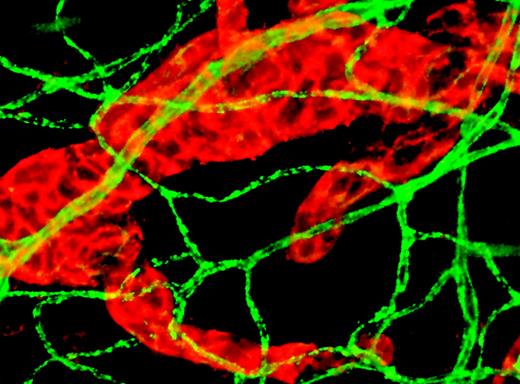Two articles in this issue of Blood identify angiopoietin-1 as a potent inducer of lymphatic angiogenesis, capable of inducing lymphatic angiogenesis in different experimental models in vivo.
The field of lymphangiogenesis research is still in its infancy. It took almost 100 years for the detailed morphologic characterization of the lymphatic vasculature by Florence Sabin to evolve into the molecular characterization of the vascular endothelial growth factor C (VEGF-C)/VEGF-D/VEGF receptor 3 (VEGFR-3) axis as a primary lymphangiogenesis-regulating system.1 More recently, VEGF-A has also been demonstrated to exert potent lymphangiogenic activity, thereby facilitating metastatic spread.2
The VEGF/VEGFR system is an almost-vascular specifically acting ligand/receptor tyrosine kinase (RTK) system that may be considered as a hierarchically high master switch of angiogenesis and lymphatic angiogenesis. Yet the lymphangiogenic activity of other angiogenesis-regulating RTKs, such as the EphB/ephrinB3 and the angiopoietin/Tie24 ligand/receptor systems, is also unravelled by recent work.
The angiopoietin/Tie2 system has been identified as a vessel maturation and quiescence-controlling molecular system.5 Angiopoietin-1 (Ang-1) is the agonistic ligand of Tie2. It regulates endothelial cell survival and blood vessel maturation, thereby exerting a vessel-sealing effect and acting as an anti-inflammatory cytokine.5 In turn, angiopoietin-2 (Ang-2) acts as functional antagonist of Ang-1. It binds to Tie2 without inducing signal transduction in Tie2-expressing endothelial cells. The antagonistic mode of action of Ang-1 and Ang-2 has also been supported by the phenotype of corresponding knockout and transgenic mice, with Ang-1-deficient mice largely phenocopying the embryonic lethal phenotype of Ang-2-overexpressing mice. In other words, too little Ang-1 equals too much Ang-2.FIG1
Double staining of skin blood vessels (green) and lymphatic vessels (orange). See the complete figure in the article beginning on page 4642.
Double staining of skin blood vessels (green) and lymphatic vessels (orange). See the complete figure in the article beginning on page 4642.
In contrast to the embryonic lethal phenotype of Ang-1-deficient mice, Ang-2-null mice develop normally to term.4 Ang-2-null mice in the 129J background have a mild postnatal vascular remodeling defect, and they die within 14 days after birth as a consequence of disturbed lymphatic patterning that leads to a chylousascites.4 These findings provided the first evidence that the Ang/Tie2 system also plays a rate-limiting role in the development of the lymphatic system. Surprisingly, the knock-in of Ang-1 into the Ang-2 locus rescued the lymphatic defectin Ang-2-null mice but not the vascular remodeling defect.4 These findings provided circumstantial evidence that Ang-1 and Ang-2 may be antagonistic molecules in the blood vascularsystem, whereas they may both be agonistic, receptor-activating molecules in the lymphatic vasculature.
In this issue, Tammela and colleagues and Morisada and colleagues shed further light into the lymphangiogenesis-regulating role of Ang-1. Both groups independently demonstrate that lymphatic endothelial cells express Tie2 and that Ang-1 is capable of inducing lymphatic angiogenesis. Tammela et al demonstrate lymphangiogenic activity in the skin of K14-Ang-1 transgenic mice as well as after viral delivery of Ang-1. Morisada et al employ the corneal angiogenesis assay to demonstrate that a modified Ang-1, COMP-Ang-1, delivered as recombinant protein is capable of inducing lymphatic angiogenesis.
The findings of these studies substantiate a critical role for the Ang/Tie2 system in controlling lymphatic angiogenesis. Yet they also raise a plethora of questions about the mechanism of action of the angiopoietins on the blood vascular and the lymphatic systems. Is Ang-1 a direct inducer of lymphatic angiogenesis, or is it acting by regulating VEGFR-3, as suggested by Tammela et al? What dissociates angiopoietin functions in blood vessels and in lymphatic vessels? What is the role of Ang-2 in lymphatic angiogenesis? How are Ang-1 and Ang-2 spatiotemporally controlled and presented in the lymphatic vasculature? Ang-1 acts in the blood vascular system as a paracrine cytokine whose functions are counteracted by autocrine endothelial cell-produced and -stored Ang-2.6 Are similar mechanisms operative in the lymphatic vasculature?
The work by Tammela et al and Morisada et al sheds important light on the molecular control of lymphatic angiogenesis, and will stimulate research into the pathophysiologic relevance of the reported findings and the molecular and cellular mechanisms of angiopoietin functions. ▪


This feature is available to Subscribers Only
Sign In or Create an Account Close Modal